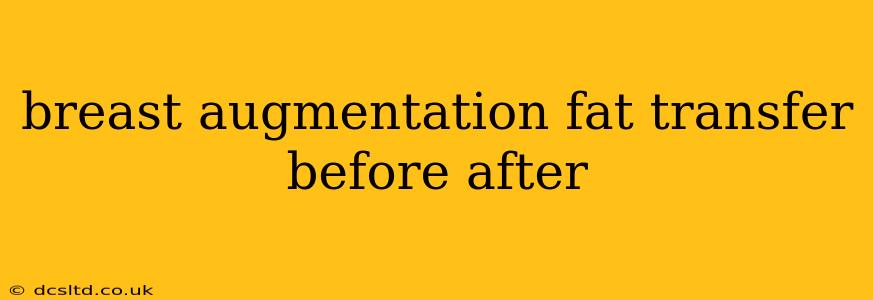Breast augmentation using fat transfer, also known as autologous fat grafting or lipofilling, is a procedure where fat is harvested from one area of the body (typically the abdomen, thighs, or hips) and injected into the breasts to increase their size and improve their shape. This minimally invasive technique offers a natural-looking result, as the augmentation is achieved using the patient's own tissue. However, it's crucial to understand the procedure's nuances before making a decision. This comprehensive guide explores the before and after aspects, addressing frequently asked questions and providing valuable insights.
What Does a Breast Augmentation Fat Transfer Involve?
Before the procedure, a consultation with a board-certified plastic surgeon is essential. The surgeon will assess your breast tissue, desired outcome, and overall health to determine suitability. The procedure typically involves three stages:
- Liposuction: Fat is harvested from a donor site using liposuction. This involves small incisions and cannulas to gently extract fat cells.
- Processing: The harvested fat is then processed to separate the fat cells from other fluids and tissues, ensuring only viable fat cells are injected.
- Injection: The purified fat is carefully injected into the breasts using specialized cannulas. Multiple injection points ensure even distribution and a natural-looking result.
What is the Recovery Process Like After a Fat Transfer Breast Augmentation?
Recovery time varies depending on the individual and the extent of the procedure. Expect some swelling, bruising, and discomfort in both the donor and recipient sites. Compression garments are typically worn for several weeks to minimize swelling and support the breasts. You'll likely need to take some time off work and avoid strenuous activities for several weeks. Follow-up appointments with your surgeon are crucial to monitor healing and address any concerns.
How Long Do the Results of a Fat Transfer Breast Augmentation Last?
This is a frequently asked question, and the answer isn't straightforward. The longevity of results depends on various factors, including the patient's metabolism, the quality of the transplanted fat, and post-operative care. A significant portion of the transferred fat will typically be absorbed by the body. While some fat cells are permanently incorporated into the breast tissue, it’s realistic to expect some degree of fat absorption, potentially requiring a touch-up procedure in the future.
What are the Potential Risks and Complications of Fat Transfer Breast Augmentation?
As with any surgical procedure, there are potential risks and complications associated with fat transfer breast augmentation. These can include:
- Infection: Infection at the injection or donor sites is a possibility and requires prompt medical attention.
- Swelling and Bruising: Significant swelling and bruising are common initially but usually subside within a few weeks.
- Asymmetry: Achieving perfect symmetry is challenging, and some degree of asymmetry may persist.
- Fat Necrosis: Fat cell death can occur, leading to lumps or irregularities.
- Calcification: Calcium deposits can sometimes form in the transplanted fat, but this is usually not a cause for concern.
What are the Benefits of Fat Transfer Breast Augmentation Compared to Implants?
Fat transfer offers several potential advantages over traditional breast implants:
- Natural Look and Feel: The use of your own fat cells results in a more natural look and feel, often considered less artificial than implants.
- Improved Breast Shape: Fat transfer can effectively correct asymmetries and improve overall breast shape.
- No Foreign Body: Avoiding implants eliminates the risk of implant-related complications like rupture or capsular contracture.
How Much Does a Fat Transfer Breast Augmentation Cost?
The cost of fat transfer breast augmentation varies considerably depending on several factors, including the surgeon's fees, anesthesia costs, facility fees, and the extent of the procedure. It's essential to obtain a detailed cost breakdown from your chosen surgeon before proceeding.
Are there Alternatives to Fat Transfer Breast Augmentation?
Yes, several alternatives exist for breast augmentation, including traditional silicone or saline implants. The best option depends on individual factors, including desired outcome, health status, and personal preferences. A thorough consultation with a qualified plastic surgeon is essential to determine the most suitable approach.
How Can I Find a Qualified Plastic Surgeon for Breast Augmentation Fat Transfer?
Choosing a board-certified plastic surgeon with extensive experience in fat transfer breast augmentation is crucial. Look for surgeons with a strong track record, positive patient reviews, and a commitment to patient safety. Don't hesitate to schedule consultations with multiple surgeons to compare their approaches and find the best fit for your needs.
Remember, this information is for general knowledge only and should not be considered medical advice. Always consult with a qualified medical professional before making any decisions regarding your health or treatment.
